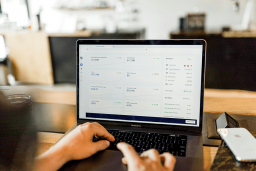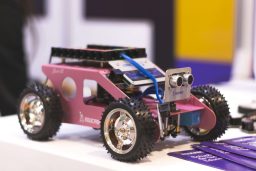A food delivery app is a business with great potential for development. According to Statista, the number of users of the meal delivery market worldwide is expected to reach over 2.5 million by 2028, and the grocery delivery market worldwide can reach over 2 million customers by 2028. These numbers show the significance of this domain and bright prospects for your food delivery application.
This article will tell you how to develop a food delivery app to please your customers and ensure the highest application security.
Key points
Business model of a mobile food delivery app
The key function for the sake of which such services are developed is to connect the customer with the entrepreneur. The typical model of interaction between the participants in this segment looks like this:
- Customer decides to eat.
- He or she enters the app and chooses a restaurant/cafe/cookery and a dish.
- He or she makes an order.
- The information goes to the supplier, then to the kitchen, and then cooking starts.
- Finished food is handed over to the courier, who delivers it to the address.
- At the moment of order placement, the client checks the delivery and pays if he or she has not done so before through the app.
This scheme is realized in practice in 3 variants.
Food aggregator
The share of such platforms in the market is the most significant. They are based on the principle of a marketplace. A food delivery application is a platform where cafes and restaurants list menus and the cost of dishes, and customers compare and order.
The restaurants prepare and deliver the food. The food aggregator app works as a bulletin board. In some cases, it is responsible for payment, accepting money from users, and passing it on to the supplier.
The peculiarity of food aggregator development is that the platform provides the interface and functionality for only two types of users – the client and the restaurant. This is also the main difference between food aggregators and other business models. In other cases, there will be three interfaces – for the client, the restaurant, and the courier.
Delivery service app
This is the same food aggregator but already responsible for delivery. For many establishments with a kitchen, this is the best option. Such a service allows any restaurant to declare itself without investing in the organization of its own courier service.
Developing a mobile food delivery application of this type requires more effort than launching a food aggregator. The reason is the need to create a separate interface for couriers and set up the processes of its interaction with the program on the side of the restaurant and the client: order transfer, chat, location control, finances, etc.
Cloud kitchen (ghost kitchen / dark kitchen)
The approach assumes cooperation with businesses that work only for online delivery or the creation of the entire business on a turnkey basis. Developing such a service, you need to think not only about the web platform but also about purchasing and placing equipment, cooking, hiring and training staff, and organizing logistics.
The mobile application for food delivery will be responsible for the menu, cash register, order status control, and courier route. Sometimes, document management and accounting are added to the standard functional set to optimize management.
Mobile food delivery app monetization
Creating a food delivery app is not a cheap process. Most often, the business uses the following methods of monetization:
- Fees – the % that the delivery service receives from the restaurant for each customer brought in
- Advertising – selling free space on the pages of the application
- Delivery payment – money the customer pays for the courier service; the rate can be fixed or floating, depending on the neighborhood, total amount, or speed of order fulfillment
The most optimal strategy can be considered a universal approach using all of the above methods. Depending on the conditions, you can focus your efforts, for example, on getting fees while selling advertising as part of your own marketing strategy.
Food delivery app development
Here are 6 components you must implement in your food delivery application.
UI / UX design
Visuals are important for the food industry. It is possible to start a food delivery app development with design because the appearance of the service reflects on the user experience in the first place. At the same time, the business model, more precisely – the number of roles in it (restaurant, client, courier), will influence the variety of design options.
Conventionally, the process of working with the food delivery application design consists of 3 stages:
- Layout preparation – a general plan of what the app will be like
- Implementation – coding, working with graphic and text elements
- Tests – the technical stability of the app and the effectiveness of the chosen concept, user reaction to the quality of usability are checked
You should remember that during the implementation process, the design may change due to new ideas and hypotheses, error detection, feedback, and A/B-testing results.
User Profile
If the food ordering app is going to integrate payment services and work with personal data, the project needs to create/connect a CRM system. Currently, food delivery applications offer visitors several registration options:
- By email
- By phone, with SMS-code verification
- Through social networks
In addition, virtually all applications allow registration through integration with Google Play and/or App Store. This is convenient for users and, therefore, can positively influence loyalty.
Geolocation
It’s hard to imagine a modern restaurant food delivery app without navigation tools. Tracking the client’s location, prompts to find the nearest cafe or pizzeria, controlling the movement of couriers, and laying the shortest route from the restaurant to the delivery address are typical tasks. The app must solve them by default.
For this purpose, the application should interact with GPS in the customers’ devices and online maps. The choice of geolocation utilities is determined by the platform on which the service is built. While iOS usually uses MapKit, Android uses traditional Google Maps.
This is an important point, as the complexity of development in both cases may differ, which will eventually affect the cost of the food delivery project.
Finances
Payment for orders or intermediary services in this process requires the application to integrate with financial services – software solutions that automate the transfer of funds from buyer to seller. Selecting and connecting such a tool is not an easy task. The process of mutual settlements must be convenient, stable, and secure simultaneously.
For this purpose, as a rule, payment gateways are used. These systems allow you to connect your food delivery service application simultaneously to several banking/electronic services, such as Payoneer, China UnionPay, PayPal, Google Pay, etc. This approach allows you to significantly reduce the hours spent on development and thus reduce the cost of the product.
Analytics
Analytical tools are implemented at this stage, and an event system is built. We mean a structure that will track key user actions (swipes, clicks, transitions between screens, purchases, opening/closing) within the application.
A properly configured collection of analytics allows one to understand how and why a user performs certain actions. This can help optimize usability.
Notifications
Notifications help customers track events in the food app, such as order acceptance, handover to the courier, time remaining until delivery, etc. As customers gain control, this can positively influence user experience and increase customer loyalty. Two types of notifications are most commonly used: push and SMS.
How much does a food delivery app cost?
It is difficult to give an unambiguous answer to this question. The final cost of the food delivery app will depend on the business model, the functional set, and the developer’s rate. Whether you intend to make a food delivery app from scratch or plan to use ready-made solutions for this purpose is also important.
The minimum cost of developing a food delivery app starts from $15,000 and requires a minimum of three months. The average price of a competitive project is $40,000, and the time to create it is 6 months.
Conclusion
Choosing the right IT partner is crucial to developing a successful food delivery application. If you want to launch your food delivery app quickly, we are here to help you! We have already participated in the development of food delivery apps, such as RapidEx. Our SoloWay Tech team knows all the solutions you can apply to your mobile app to speed up its development. With us, you can launch your MVP in a matter of weeks.





